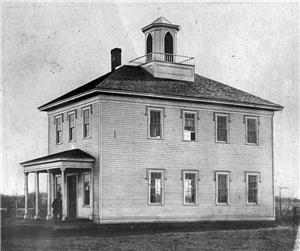On December 20, 1859, the Washington Territorial Legislature approves the first charter for an institution of higher educational in the territory. The charter is for Whitman Seminary, a coeducational pre-collegiate academy, which is to be located at the mission site where Marcus and Narcissa Whitman worked from 1836 until 1847, when they were killed by a group of Cayuse Indians. The first classes are not held until 1866, and the school begins in the city of Walla Walla rather than at the nearby mission site. After many years of struggle, in 1882 Whitman College begins offering college curricula and the school attracts more support and students. During the twentieth century Whitman College will emerge as a distinguished liberal arts college.
A Memorial to the Whitmans
In 1859, after the land east of the Cascades was opened for resettlement, Cushing Eells (1810-1893) visited the mission site of his former colleagues Marcus and Narcissa Whitman. The Whitmans, responding to a call by tribal peoples for missionaries, established their mission site, Waiilatpu, near present-day Walla Walla, Washington, in 1836. In 1847, they were killed by a group of Cayuse Indians. As Eells considered the fate of the Whitmans and the future of the region, he resolved to establish a “monument” to the Whitmans in the form of a high school for pioneer boys and girls.
With the support of other Congregational ministers, in 1859 Eells obtained a charter for Whitman Seminary from the Washington territorial government. That same year, he acquired the Whitman mission site from the American Board of Commissioners for Foreign Missions. Eells soon moved with his family to the former mission site and began working to establish Whitman Seminary. Eells donated more than half of the site’s land to the school, but local pressure and resources provided a way for the school to open in the city of Walla Walla. In 1866, Walla Walla’s wealthiest denizen, merchant Dorsey Syng Baker (1823-1888), donated land near his home. A wood-frame building was quickly erected for the school and classes began later that year, with a principal, two assistants, and 36 students.
From Academy to College
Whitman Seminary opened with great ambitions and fanfare, but within a year the school’s first principal, local Congregational minister Peasly B. Chamberlin, resigned. Eells took over as principal for two years but also resigned, claiming that he lacked the energy to continue. After Eells’s resignation, the school was unable to retain teachers and students, and it failed to remain open for each term. Realizing that their school could not compete with local private and public schools, Whitman’s trustees thought the school might be able to survive as the region’s first college.
In 1882, Whitman trustees called Alexander J. Anderson (1832-1903), the recently resigned president of the Territorial University (later the University of Washington), to become the first president of Whitman College. With development support from the Congregational American College and Education Society, Anderson was able to successfully start Whitman College, a liberal arts college modeled on such New England colleges as Williams. A new charter for the school was obtained in 1883. In 1907, Whitman ended its relationship with the Congregational Church and became an independent college. In spite of periodic financial struggles, Whitman College emerged as a premier liberal arts college.

